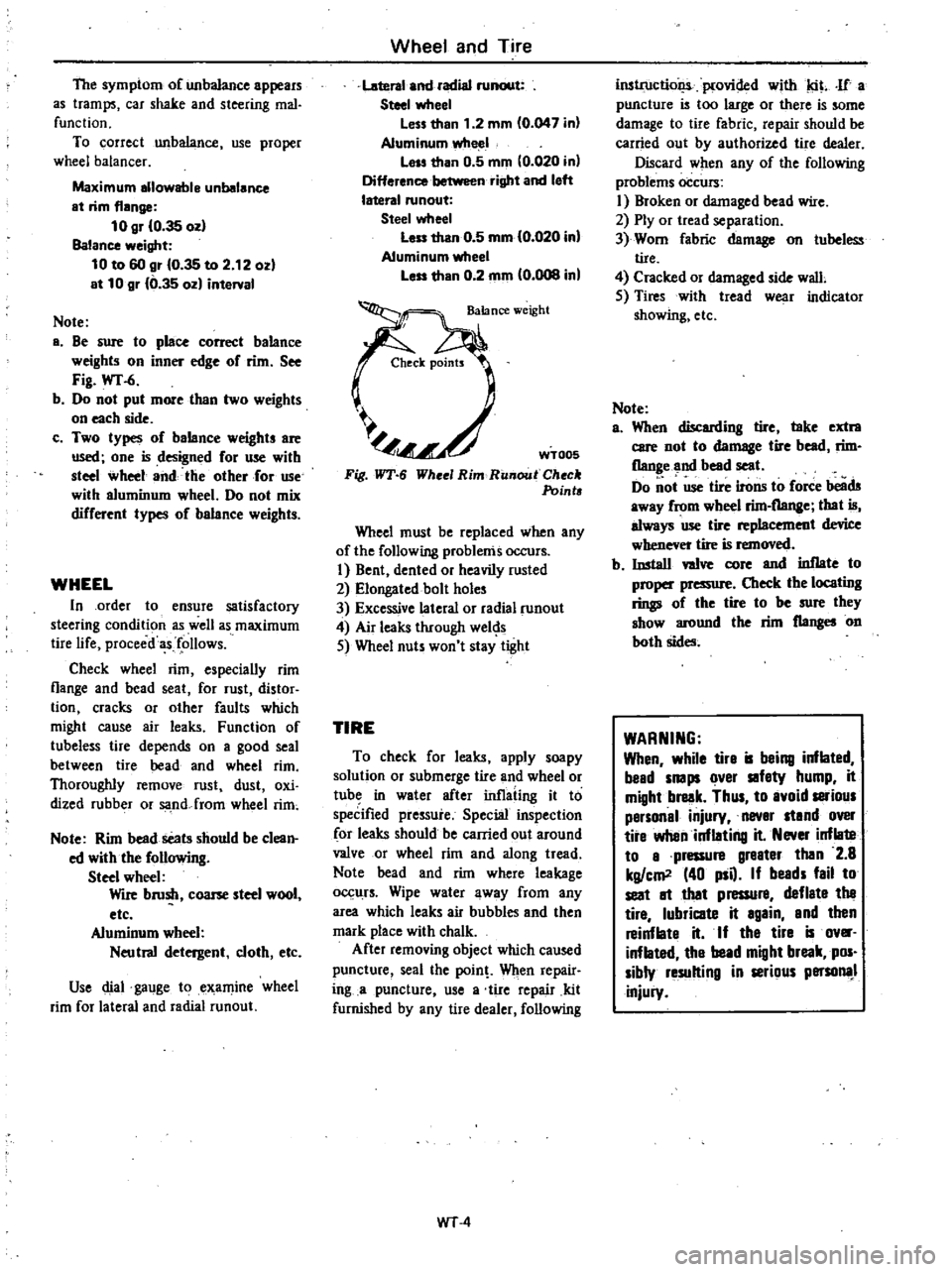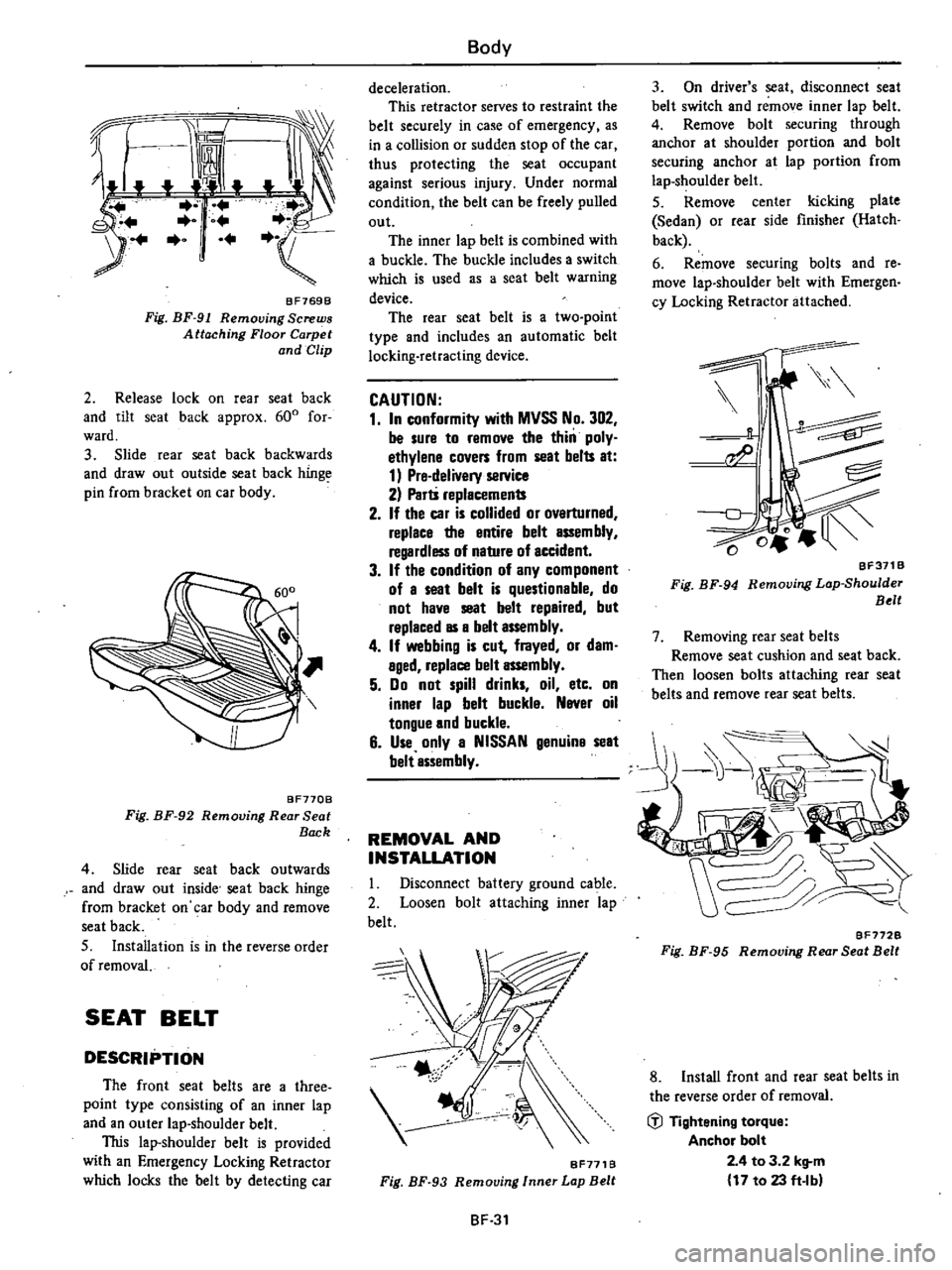tire type DATSUN 210 1979 User Guide
[x] Cancel search | Manufacturer: DATSUN, Model Year: 1979, Model line: 210, Model: DATSUN 210 1979Pages: 548, PDF Size: 28.66 MB
Page 380 of 548

The
symptom
of
unbalance
appears
as
tramps
car
shake
and
steering
mal
function
To
correct
unbalance
use
proper
wheel
balancer
Maximum
allowable
unbalance
at
rim
flange
10
gr
10
35
ozl
Balance
weight
10
to
60
gr
10
35
to
2
12
ozl
at
10
gr
10
35
ozl
interval
Note
a
Be
sure
to
place
correct
balance
weights
on
inner
edge
of
rim
See
Fig
wr
6
b
Do
not
put
mOle
than
two
weights
on
each
side
c
Two
types
of
balance
weights
are
used
one
is
designed
for
use
with
steel
wheel
and
the
other
for
use
with
aluminum
wheel
Do
not
mix
different
types
of
balance
weights
WHEEL
In
order
to
ensure
satisfactory
steering
condition
as
well
as
maximum
tire
life
proceed
follows
Check
wheel
rim
especially
rim
flange
and
bead
seat
for
rust
distor
tion
cracks
or
other
faults
which
might
cause
air
leaks
Function
of
tubeless
tire
depends
on
a
good
seal
between
tire
bead
and
wheel
rim
Thoroughly
remove
rust
dust
oxi
dized
rubber
or
sa
nd
from
wheel
rim
Note
Rim
bead
seats
should
be
clean
ed
with
the
following
Steel
wheel
Wile
brush
coone
steel
wool
etc
Aluminum
wheel
Neutral
detergent
cloth
etc
Use
dial
gauge
to
examine
wheel
rim
for
lateral
and
radial
runout
Wheel
and
Tire
Lateral
and
radial
runout
Steel
wheel
less
than
1
2
mm
0
047
in
Aluminumwlte
1
lass
than
0
5
mm
10
020
in
Difference
right
and
left
lateral
runout
Steel
wheel
leu
than
0
5
mm
10
020
in
Aluminum
wheel
less
than
0
2
mm
0
008
in
C
JeCk
points
l
Fig
WT
6
WT005
Whee
Rim
RUllout
Check
Points
Wheel
must
be
replaced
when
any
of
the
following
problems
occurs
I
Bent
dented
or
heavily
rusted
2
Elongated
bolt
holes
3
Excessive
lateral
or
radial
runout
4
Air
leaks
through
wel
s
5
Wheel
nuts
won
t
stay
tight
TIRE
To
check
for
leaks
apply
soapy
solution
or
submerge
tire
and
wheel
or
tub
in
water
after
inflating
it
to
speCified
pressure
Special
inspection
for
leaks
should
be
carried
out
around
valve
or
wheel
rim
and
along
tread
Note
bead
and
rim
where
leakage
0
11rs
Wipe
water
away
from
any
area
which
leaks
air
bubbles
and
then
mark
place
with
chalk
After
removing
object
which
caused
puncture
seal
the
pain
Wilen
repair
ing
a
puncture
use
a
tire
repair
kit
furnished
by
any
tire
dealer
following
WT
4
inslrt1ctiol
iplovided
with
tit
If
a
puncture
is
too
large
or
there
is
some
damage
to
tire
fabric
repair
should
be
carried
out
by
authorized
tire
dealer
Discard
when
any
of
the
following
problems
occurs
I
Broken
or
damaged
bead
wire
2
Ply
or
tread
separation
3
Worn
fabric
damage
on
tubeless
tire
4
Cracked
or
damaged
side
wall
5
Tires
with
tread
wear
indicator
showing
etc
Note
a
When
discarding
tire
take
extra
care
not
to
damage
tire
bead
rim
flange
and
bead
seat
Do
ot
use
tire
irons
to
foree
beads
away
from
wbeel
rim
flange
that
is
always
use
tire
replacement
device
whenever
tire
is
removed
b
Install
wive
core
and
inflate
to
proper
pressure
Check
the
locating
rings
of
the
tire
to
be
sure
they
show
around
the
rim
flanges
on
both
sides
WARNING
When
while
tire
is
being
inflated
bead
snaps
over
safety
hump
it
might
break
Thus
to
avoid
satious
personal
injury
never
stand
over
tire
when
inflating
it
Never
inflate
to
a
pressure
greater
then
2
8
kg
em
40
psQ
If
beads
fail
to
seat
It
that
pressure
deflate
the
tire
lubricate
it
again
and
then
reinflate
it
If
the
tire
is
ov
inflated
the
bead
might
break
pos
sibly
resulting
in
serious
persona
injury
Page 442 of 548

Z
jJ
BF769B
Fig
BF
91
Removing
Screws
Attaching
Floor
Carpet
and
Clip
2
Release
lock
on
rear
seat
back
and
tilt
seat
back
approx
600
for
ward
3
Slide
rear
seat
back
backwards
and
draw
out
outside
seat
back
hinge
pin
from
bracket
on
car
body
BF770B
Fig
BF
92
Removing
Rear
Seat
Back
4
Slide
rear
seat
back
outwards
and
draw
out
inside
seat
back
hinge
from
bracket
on
car
body
and
remove
seat
back
S
Installation
is
in
the
reverse
order
of
removal
SEAT
BELT
DESCRIPTION
The
front
seat
belts
are
a
three
point
type
consisting
of
an
inner
lap
and
an
outer
lap
shoulder
belt
This
lap
shoulder
belt
is
provided
with
an
Emergency
Locking
Retractor
which
locks
the
belt
by
detecting
car
Body
deceleration
This
retractor
serves
to
restraint
the
belt
securely
in
case
of
emergency
as
in
a
collision
or
sudden
stop
of
the
car
thus
protecting
the
seat
occupant
against
serious
injury
Under
normal
condition
the
belt
can
be
freely
pulled
out
The
inner
lap
belt
is
combined
with
a
buckle
The
buckle
includes
a
switch
which
is
used
as
a
seat
belt
warning
device
The
rear
seat
belt
is
a
two
point
type
and
includes
an
automatic
belt
locking
retracting
device
CAUTION
1
In
conformity
with
MVSS
No
302
be
sure
to
remove
the
thin
poly
ethylene
covers
from
seat
belts
at
1
Pre
delivery
service
2
Parti
replacements
2
If
the
car
is
collided
or
ovarturned
replace
the
entire
belt
assembly
regardless
of
nature
of
accident
3
If
the
condition
of
any
component
of
a
seat
belt
is
questionable
do
not
have
seat
belt
repaired
but
raplaced
as
a
belt
assembly
4
If
webbing
is
cut
frayed
or
dam
aged
replace
belt
assembly
5
Do
not
spill
drinks
oil
etc
on
inner
lap
belt
buckla
Naver
oil
tongue
and
buckle
6
Use
only
a
NISSAN
genuina
seat
belt
assembly
REMOVAL
AND
INSTALLATION
I
Disconnect
battery
ground
cable
2
Loosen
bolt
attaching
inner
lap
belt
BF771B
Fig
BF
93
Removing
Inner
Lap
Belt
BF
31
3
On
driver
s
seat
disconnect
seat
belt
switch
and
remove
inner
lap
belt
4
Remove
bolt
securing
through
anchor
at
shoulder
portion
and
bolt
securing
anchor
at
lap
portion
from
lap
shoulder
belt
5
Remove
center
kicking
plate
Sedan
or
rear
side
finisher
Hatch
back
6
Remove
securing
bolts
and
re
move
lap
shoulder
belt
with
Emergen
cy
Locking
Retractor
attached
BF311B
Fig
BF
94
Removing
Lop
Shoulder
Belt
7
Removing
rear
seat
belts
Remove
seat
cushion
and
seat
back
Then
loosen
bolts
attaching
rear
seat
belts
and
remove
rear
seat
belts
BF772B
Fig
BF
95
Removing
Rear
Seat
Belt
8
Install
front
and
rear
seat
belts
in
the
reverse
order
of
removal
iil
Tightening
torque
Anchor
bolt
2
4
to
3
2
kg
m
17
to
23
ft
Ibl